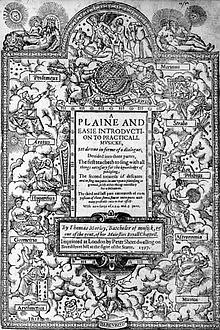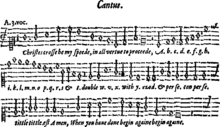LIMSwiki
Contents
Thomas Morley | |
|---|---|
 Title page of Morley's Plaine and Easie Introduction to Practicall Musicke (1597) | |
| Born | c. 1557 |
| Died | early October 1602 (aged 45) |
| Occupation(s) | composer, organist and madrigalist |
Thomas Morley (1557 – early October 1602) was an English composer, theorist, singer and organist of the Renaissance. He was one of the foremost members of the English Madrigal School. Referring to the strong Italian influence on the English madrigal, The New Grove Dictionary of Music and Musicians states that Morley was "chiefly responsible for grafting the Italian shoot on to the native stock and initiating the curiously brief but brilliant flowering of the madrigal that constitutes one of the most colourful episodes in the history of English music."[1]
Living in London at the same time as Shakespeare, Morley was the most famous composer of secular music in Elizabethan England. He and Robert Johnson are the composers of the only surviving contemporary settings of verse by Shakespeare.
Morley was active in church music as a singer, composer and organist at St Paul's Cathedral. He was also involved in music publishing. From 1598 up to his death he held a printing patent (a type of monopoly).[2] He used the monopoly in partnership with professional music printers such as Thomas East.
Life
Morley was born in Norwich, the son of a brewer. Most likely he was a singer in the local cathedral from his boyhood,[1][3] and he became master of choristers there in 1583.[4] He may have been a Roman Catholic, but he was able to avoid prosecution as a recusant, and there is evidence that he may have been an informer on the activities of Roman Catholics.[2]
It is believed that Morley moved from Norwich to London sometime before 1574 to be a chorister at St. Paul's Cathedral.[1] Around this time,[2] he studied with William Byrd, whom he named as his mentor in his 1597 publication A Plain and Easie Introduction to Practicall Musicke. Byrd also taught Morley's contemporary, Peter Philips.[1] In 1588 he received his bachelor's degree from the University of Oxford, and shortly thereafter was employed as organist at St. Paul's in London. His young son died the following year in 1589. He and his wife Susan had three more children between 1596 and 1600.
In 1588 Nicholas Yonge published his Musica transalpina, the collection of Italian madrigals fitted with English texts, which touched off the explosive and colourful vogue for madrigal composition in England. Morley found his compositional direction at this time, and shortly afterwards began publishing his own collections of madrigals (11 in all).
Morley lived for a time in the same parish as Shakespeare, and a connection between the two has been long speculated, but never proven. His famous setting of "It was a lover and his lass" from As You Like It has never been established as having been used in a performance of Shakespeare's play during the playwright's lifetime.[citation needed] However, given that the song was published in 1600, there is evidently a possibility that it was used in stage performances.

While Morley attempted to imitate the spirit of Byrd in some of his early sacred works, it was in the form of the madrigal that he made his principal contribution to music history. His work in the genre has remained in the repertory to the present day, and shows a wider variety of emotional colour, form and technique than anything by other composers of the period. Usually his madrigals are light, quick-moving and easily singable, like his well-known "Now Is the Month of Maying" (which is actually a ballett); he took the aspects of Italian style that suited his personality and anglicised them. Other composers of the English Madrigal School, for instance Thomas Weelkes and John Wilbye, were to write madrigals in a more serious or sombre vein.
In addition to his madrigals, Morley wrote instrumental music, including keyboard music (some of which has been preserved in the Fitzwilliam Virginal Book), and music for the broken consort, a uniquely English ensemble of two viols, flute, lute, cittern and bandora, notably as published by William Barley in 1599 in The First Booke of Consort Lessons, made by diuers exquisite Authors, for six Instruments to play together, the Treble Lute, the Bandora, the Cittern, the Base-Violl, the Flute & Treble-Violl.
Morley's Plaine and Easie Introduction to Practicall Musicke (published 1597) remained popular for almost two hundred years after its author's death, and is still an important reference for information about sixteenth century composition and performance.
Thomas Morley was buried in the graveyard of the church of St Botolph Billingsgate, which was destroyed in the Great Fire of London of 1666, and not rebuilt. Thus his grave is lost.
Compositions
Thomas Morley's compositions include (in alphabetical order):
- April is in my mistress' face
- Arise, get up my deere
- Cease mine eyes
- Come, lovers, follow me
- Come, Sorrow, come
- Crewell you pull away to soone
- Christes crosse
- Do you not know?
- Fair in a morn
- Fantasia for keyboard, Fitzwilliam Virginal Book CXXIV
- Fantasie: Il Doloroso
- Fantasie: Il Grillo
- Fantasie: Il Lamento
- Fantasie: La Caccia
- Fantasie: La Rondinella
- Fantasie: La Sampogna
- Fantasie: La Sirena
- Fantasie: La Tortorella
- Fire Fire My Heart
- Flora wilt thou torment mee
- Fyre and Lightning
- Goe yee my canzonets
- Good morrow, Fayre Ladies of the May
- Harke Alleluia!
- Hould out my hart
- I goe before my darling
- I saw my Lady weeping
- I should for griefe and anguish
- In nets of golden wyers
- It was a lover and his lass
- Joy, joy doth so arise
- Joyne hands
- La Caccia "The Chase"
- La Girandola
- Ladie, those eies
- Lady if I through griefe
- Leave now mine eyes
- Lirum, Lirum
- Lo hear another love
- Love learns by laughing
- Miraculous loves wounding
- Mistress mine
- My bonny lass she smileth
- Nolo mortem peccatoris
- Now is the month of maying
- O Mistresse mine
- O thou that art so cruell
- A painted tale
- Say deere, will you not have me?
- See, see, my own sweet jewel
- Shepard's Rejoice
- Sing we and chant it[5]
- Sleep, slumb'ring eyes
- Sweet nymph
- Thirsis and Milla
- Those dainty daffadillies
- Though Philomela lost her love Oxford Book of English Madrigals
- 'Tis the time of Yuletide Glee
- Well Hall
- What is it that this dark night
- What ayles my darling?
- When loe by break of morning
- Where art thou wanton?
- Will you buy a fine dog?[6]
- With my love my life was nestled
Sacred music
- The Burial Service
- De profundis clamavi
- Domine, dominus noster
- Domine, non est exultarem cor meum
- Eheu sustulerunt domine
- The First Service
- How long wilt thou forget me?
- O amica mea
See also
- The Triumphs of Oriana edited by Morley, published in 1601
References
- ^ a b c d Brett, Philip; Murray, Tessa (11 February 2013). "Thomas Morley". Oxford Music Online. Oxford University Press. Retrieved 5 February 2016.
- ^ a b c Foster, Michael W.. "Morley, Thomas (b. 1556/7, d. in or after 1602)." Michael W. Foster in Oxford Dictionary of National Biography, online ed., edited by Lawrence Goldman. Oxford: OUP. http://www.oxforddnb.com/view/article/19292 (accessed 18 November 2014) Subscription or UK public library membership required.
- ^ Murray, Tessa (2014). Thomas Morley: Elizabethan Music Publisher. Woodbridge: Boydell Press. p. 8. ISBN 978-1-84383-960-6.
- ^ Murray, Tessa (2014). Thomas Morley: Elizabethan Publisher. Woodbridge: Boydell Press. pp. 20–21. ISBN 978-1-84383-960-6.
- ^ "Sing we and chant it – Morley". Youtube. Retrieved 18 June 2022.
- ^ "Will you buy a fine dog?". Youtube. Retrieved 22 July 2020.
Further reading
- Gustave Reese, Music in the Renaissance. New York, W.W. Norton & Co., 1954. ISBN 0-393-09530-4
- Article "Thomas Morley" in The New Grove Dictionary of Music and Musicians, ed. Stanley Sadie. 20 vol. London, Macmillan Publishers Ltd., 1980. ISBN 1-56159-174-2
- The University of Reading Library featuring: Thomas Morley, A Plaine and Easie Introduction to Practicall Musicke. London, 1597 [1]
- Philip Ledger (ed) The Oxford Book of English Madrigals OUP 1978
- The Madrigal, Jerome Roche, 1972. ISBN 0-09-113260-6
- Shaw, Watkins (1965). "Thomas Morley of Norwich". The Musical Times. 106 (1471). Musical Times Publications Ltd.: 669–673. doi:10.2307/954169. JSTOR 954169.
External links
- Works by or about Thomas Morley at the Internet Archive
- Works by Thomas Morley at LibriVox (public domain audiobooks)

- Free scores by Thomas Morley in the Choral Public Domain Library (ChoralWiki)
- Free scores by Thomas Morley at the International Music Score Library Project (IMSLP)
- More information, including full text, of Morley's Plaine and Easie Introduction to Practicall Musicke at the University of North Texas Music Library's Virtual Rare Book Room
- HTML transcription, with numbered page divisions, of Plaine and Easie Introduction to Practicall Musicke: pp. 1–68, 69–115, and 116–183 and end matter (at the Jacobs (Indiana University) School of Music Center for the History of Music Theory and Literature)

















